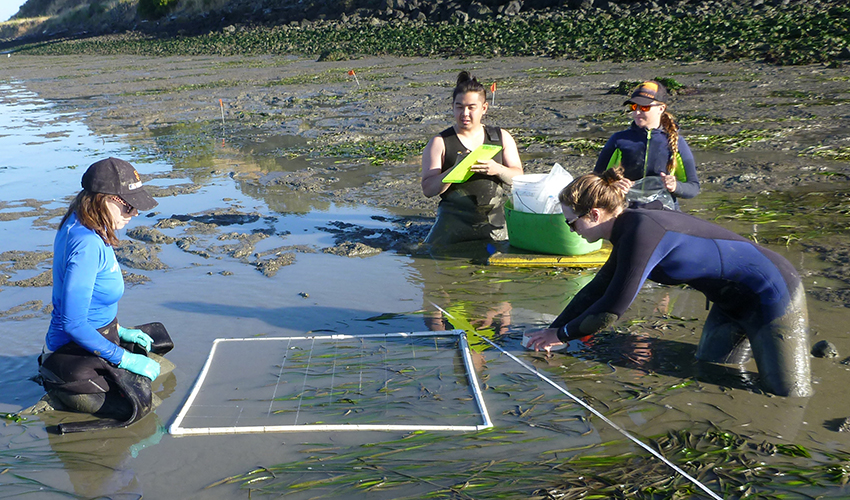Romberg biologists helping get new Smithsonian project off the ground

SF State student Melissa Patten, left, student Michael Izumiyama, research technician Stephanie Kiriakopolos and student Crystal Weaver measure seagrass densities and lengths in San Francisco Bay. The Romberg Tiburon Center for Environmental Studies has joined the Smithsonian Institution's MarineGEO project, aimed at better understanding marine ecosystems and how they may be affected by climate change. Credit: Emmett Duffy, Smithsonian Institution
SF State is first West Coast institution to join global partnership to monitor marine ecosystems
Researchers at San Francisco State University’s Romberg Tiburon Center (RTC) for Environmental Studies have joined a global partnership, led by the Smithsonian Institution, aimed at better understanding the world’s marine ecosystems and how they may be affected by climate change.
RTC, the Smithsonian’s first West Coast partner, is poised to play a major role in getting the initiative off the ground. The MarineGEO project is a worldwide network of observation sites and research centers. Biologists at each site will collect data annually, and over time the information will allow them to predict changes to marine ecosystems, leading to more efficient conservation and restoration efforts.
“What we set up here will be modeled by other marine partners as they join the network over time,” said Kathy Boyer, a professor of biology at SF State. “We are helping the Smithsonian Institution figure out what measurements to conduct in different habitats. For example, we’re doing the first measurements of temperate seagrasses in the network.”
In conjunction with the partnership, Boyer and her Romberg colleagues, as well as several student researchers, spent the summer documenting the patterns of invertebrate animal communities in seagrass beds and mudflat habitats, comparing natural habitat areas in Richardson Bay to restored habitat there and near the Richmond Bridge. This fall, they’ll conduct similar work in salt marshes.
“We have some of the same communities of species here that are found in many other places. For example, the same seagrass species occurs in temperate estuaries throughout the northern hemisphere,” Boyer said. “It’s really exciting as a scientist to see how our little part of the world functions compared with the rest of the world.”
Boyer and fellow Professor of Biology Karen Crow hope to offer a suite of courses next spring to immerse undergraduate students in marine science research and allow them to participate in the new research partnership.
“Our strategic partnerships with the Smithsonian and the SF Bay National Estuarine Research Reserve, another key partner in the Richardson Bay MarineGEO project, connect SF State’s research in San Francisco Bay to national and global networks that provide a foundation for understanding the impacts of global and climatic changes,” said Karina Nielsen, director of the Romberg Tiburon Center. “SF State students interested in careers related to solving the environmental problems facing coastal regions are also benefiting from participation in hands-on research experiences and professional networking opportunities available to them at the Romberg Tiburon Center.”
For more information about the Romberg Tiburon Center, visit rtc.sfsu.edu.